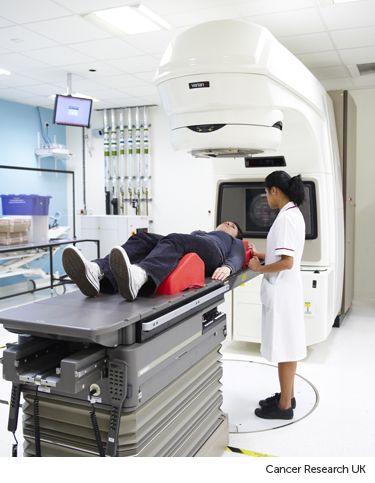Having external radiotherapy for womb cancer
Radiotherapy uses high energy x-rays to treat womb cancer cells. You have the treatment in the hospital radiotherapy department.
When you might have radiotherapy
Radiotherapy for a high-intermediate risk or high risk cancer
When you have surgery your surgeon sends what they remove for various tests in a laboratory. These tests help them work out the risk of your cancer coming back. You may need radiotherapy if your cancer is in a higher risk group.
For a high-intermediate risk womb cancer stage 1A, stage 1B grade 3, stage 2 grade 1, or stage 2 grade 2 to 3, you may have radiotherapy:
- on its own – this is the most common treatment after surgery
- with chemotherapy or chemotherapy followed by radiotherapy, or both
For a high risk cancer, you may have radiotherapy:
- with chemotherapy
- after chemotherapy
You usually have 25 treatments over 5 weeks. You have the treatment in short sessions (called fractions) daily from Monday to Friday. You don’t have treatment at weekends.
Radiotherapy if you can’t have surgery
If you can’t have surgery or if you’re not fit enough to have surgery, you may have radiotherapy for a high grade cancer.
How many treatments you have will depend on your situation. You may have between 5 and 25 treatments.
Radiotherapy to relieve symptoms of advanced cancer
Radiotherapy can help to relieve symptoms of advanced womb cancer. It may relieve symptoms such as:
- pelvic pain
- bleeding
You usually only have a short course. It might include:
- one or two treatments
- 5 treatments over a week
- 10 treatments over 2 weeks
You very rarely have more than 10 treatments.
Types of radiotherapy
You usually have a type of external radiotherapy called intensity modulated radiotherapy (IMRT).
You might also have internal radiotherapy. Internal radiotherapy gives radiotherapy to the cancer from inside the body. This is also called brachytherapy.
The radiotherapy room
Radiotherapy machines are very big and could make you feel nervous when you see them for the first time. The machine might be fixed in one position. Or it might rotate around your body to give treatment from different directions. The machine doesn't touch you at any point.
Before your first treatment, your  will explain what you will see and hear. In some departments, the treatment rooms have docks for you to plug in music players. So you can listen to your own music while you have treatment.
will explain what you will see and hear. In some departments, the treatment rooms have docks for you to plug in music players. So you can listen to your own music while you have treatment.

Before each treatment session
Before each treatment you might be asked to drink a certain amount of water. This is so your bladder is roughly the same size every day. If you need to do this then the procedure will be carefully explained to you when you have your planning scan.
You might also be asked to empty your bowels before each treatment. Not everyone has to do this.
The radiographers help you to get onto the treatment couch. You might need to raise your arms over your head.
The radiographers line up the radiotherapy machine using the marks on your body. Once you are in the right position, they leave the room.
During the treatment
You need to lie very still. Your radiographers might take images (x-rays or scans) before your treatment to make sure that you're in the right position. The machine makes whirring and beeping sounds. You won’t feel anything when you have the treatment.
Your radiographers can see and hear you on a CCTV screen in the next room. They can talk to you over an intercom and might ask you to hold your breath or take shallow breaths at times. You can also talk to them through the intercom or raise your hand if you need to stop or if you're uncomfortable.
You won't be radioactive
This type of radiotherapy won't make you radioactive. It's safe to be around other people, including pregnant women and children.
Travelling to radiotherapy appointments
You might have to travel a long way each day for your radiotherapy. This depends on where your nearest cancer centre is. This can make you very tired, especially if you have side effects from the treatment.
You can ask your radiographers for an appointment time to suit you. They will do their best, but some departments might be very busy. Some radiotherapy departments are open from 7 am till 9 pm.
Car parking can be difficult at hospitals. Ask the radiotherapy staff if you are able to get free parking or discounted parking. They may be able to give you tips on free places to park nearby.
Hospital transport may be available if you have no other way to get to the hospital. But it might not always be at convenient times. It is usually for people who struggle to use public transport or have any other illnesses or disabilities. You might need to arrange hospital transport yourself.
Some people are able to claim back a refund for healthcare travel costs. This is based on the type of appointment and whether you claim certain benefits. Ask the radiotherapy staff for more information about this and hospital transport.
Some hospitals have their own drivers and local charities might offer hospital transport. So do ask if any help is available in your area.
Side effects
Radiotherapy for womb cancer can cause diarrhoea and sickness. Your vagina may become sore and you may have an irritable bladder (radiation cystitis). Radiotherapy can also cause tiredness.
Side effects usually go within a few weeks of finishing treatment.
Tell your doctor, nurse or radiographer if you have any side effects, as they can give you medicines to help.



